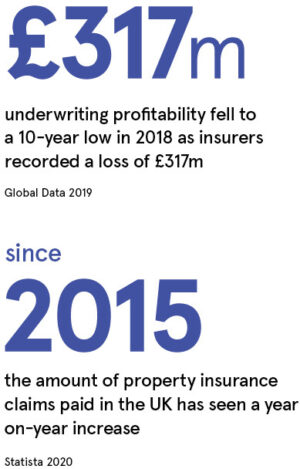
What is the traditional approach to risk in the property sector and why is it flawed?
The traditional risk transfer model for property insurance is outdated, based on the risk and the payout and the claims and the loss. This transfer is the least best way of managing risk. It perpetuates a cycle of avoidance. A property owner transfers the risk to an insurance company to avoid its consequences, when in fact it is this person or organisation that is best placed to reduce or mitigate the risk in the first place. Rather than a property owner transferring the risk to an insurer, which prices that risk based on a notional assessment, it is much better to incentivise the owner to take steps to mitigate the risk through detection and predictive analytical insight.
How is IoT technology enabling this more intelligent, proactive approach?
Real-time, data-driven insights empower a predict and prevent approach, allowing companies to move away from claims and loss. Insurers wait for a claim to happen, investigate it and then have systems that allow it to be paid to a client. Powered by data science and IoT capabilities, we precisely predict and prevent the risk occurring in the first place. The new Shepherd risk mitigation model allows both property owners and insurers to gain a true understanding of risk in real time. This is game-changing and empowers all stakeholders to better manage and mitigate risks, resulting in improved loss ratios for insurers while reducing costs and disruption for the property owners.
It’s important to embrace the power of IoT but understand that it is not the end game
Can you expand on how Shepherd is helping to facilitate predict and prevent?
Shepherd creates new knowledge about the way a property is performing and its inherent risks. We do this by precisely exposing and understanding the causality of risk and therefore empowering the owner and insurer to better manage them. For example, in a sawmill, we are providing a deeper understanding into the causes of fire. This powers our predictive capability to prevent a loss event. Another example is English Heritage where we’re preventing catastrophic loss to priceless artefacts and heritage property. With Kenwood House, we’ve taken an 18th-century building and put it onto the same data level as the Shard to provide many actionable insights enabling the smarter management of the property and environment.
How do you work with companies to ensure they are collecting and processing the right data?

Data derived from IoT needs to be aligned to the wider business objectives. To this end, we work backwards with the insurer and property owner, starting by identifying the inherent risks that are specific to a property or portfolio of properties. From there we pinpoint what information is required to mitigate those risks, so we understand what data inputs Shepherd requires for analysis. We utilise numerous methods to extract and collect data, including IoT-enabled sensors, building management systems and external data. It’s important to embrace the power of IoT, but understand that it is not the end-game. Data analysed is new information and information layered and shared creates new knowledge. It is this new knowledge that enables businesses to make better, smarter and more-informed business-critical decisions.
What does this new innovation mean for property management?
It’s an enormous step forward, a digital transformation in the true sense and a way for insurers to attract and retain more clients while improving their claims-loss ratio by facilitating better decision-making. Moving from claims and loss to predict and prevent encourages new revenue streams and new ways of thinking on how to reduce rather than just transfer risk. Meanwhile, risk mitigation doesn’t just apply to the insurability of a property. These IoT insights are hugely valuable to property owners in terms of energy consumption, typically driving a 25 per cent energy reduction, and help optimise assets and reduce downtime. Rather than a facilities management team waiting for something to break while carrying out a regular maintenance schedule, Shepherd’s condition-based monitoring system can tell them the expected lifetime of assets. We can also monitor oxygen and CO2 levels and measure air quality as well as footfall and the usage of things like heating and air conditioning so they can operate at
optimum levels.
What is the future of IoT in the property risk space?
Real-time knowledge promotes better decision-making, minimising risks and improving your ability to act. We’re already seeing a lot of consumer products coming out with embedded IoT, such as smart fridges and ovens, but next we’ll see this proliferation of smart devices move into the industrial scale. We’ll see smart pumps, boilers, heating systems, recirculation systems and fans, and this will bring a lot more data that can be ingested by Shepherd. From there we can provide richer analytical insights, allowing property owners to make better decisions about how properties are managed and maintained. At Shepherd, we’re in the business of creating new knowledge and insight. We see IoT as a fundamental part of providing this
value-added service of building and property knowledge.
For more information please visit www.shprd.com/iot-report
Promoted by Shepherd

